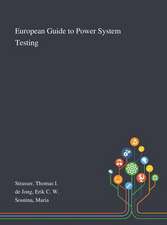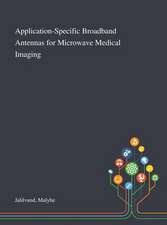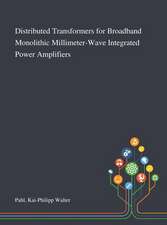5G Second Phase Explained – The 3GPP Release 16 Enhancements
Autor JTJ Penttinenen Limba Engleză Hardback – 5 mai 2021
Preț: 786.52 lei
Preț vechi: 864.31 lei
-9% Nou
Puncte Express: 1180
Preț estimativ în valută:
150.49€ • 157.15$ • 124.28£
150.49€ • 157.15$ • 124.28£
Carte tipărită la comandă
Livrare economică 15-29 aprilie
Preluare comenzi: 021 569.72.76
Specificații
ISBN-13: 9781119645504
ISBN-10: 1119645506
Pagini: 368
Dimensiuni: 171 x 253 x 26 mm
Greutate: 0.78 kg
Editura: Wiley
Locul publicării:Chichester, United Kingdom
ISBN-10: 1119645506
Pagini: 368
Dimensiuni: 171 x 253 x 26 mm
Greutate: 0.78 kg
Editura: Wiley
Locul publicării:Chichester, United Kingdom
Notă biografică
Jyrki T. J. Penttinen is the Senior Technology Manager, North America, at GSMA in Atlanta, GA, USA. He has worked in mobile telecommunications since 1994 and has experience in research and operational activities for both radio and core network domains, including planning, optimization, measurements, system architectures and services.
Cuprins
About the Author xiii
Preface xv
Acknowledgments xvii
List of Abbreviations xix
1 Introduction 1
1.1 General 1
1.1.1 Focus of This Book 1
1.1.2 Generations 2
1.2 Principles of 5G 4
1.2.1 Open Source 7
1.2.2 Justifications for 5G 8
1.3 Standardization 10
1.3.1 Release 16 Key Features 10
1.3.2 The Phases of 5G 12
1.3.3 How to Find 5G-Related Specifications 18
1.3.4 Release 17 20
1.3.5 Later Phases and 6G 21
1.4 Introduction to the Book 22
2 Requirements 27
2.1 Overview 27
2.2 Background 27
2.3 Development of the Ecosystem 28
2.3.1 New Needs 28
2.3.2 Enhanced 5G Functionality 29
2.4 Introduction to Requirements 29
2.5 World Radiocommunication Conference 31
2.6 Building Blocks of 5G: eMBB/URLLC/mMTC 31
2.7 5G Requirements of the ITU 34
2.7.1 Process 34
2.7.2 Documents 35
2.7.3 Peak Data Rate 36
2.7.4 Peak Spectral Efficiency 36
2.7.5 User Experienced Data Rate 36
2.7.6 Fifth Percentile User Spectral Efficiency 37
2.7.7 Average Spectral Efficiency 37
2.7.8 Area Traffic Capacity 37
2.7.9 Latency 37
2.7.10 Connection Density 38
2.7.11 Energy Efficiency 38
2.7.12 Reliability 38
2.7.13 Mobility 38
2.7.14 Mobility Interruption Time 39
2.7.15 Bandwidth 39
2.8 The Technical Specifications of the 3GPP 39
2.8.1 Releases 39
2.8.2 Security Requirements for 5G 41
2.9 NGMN 41
2.9.1 User Experience 41
2.9.2 Device Requirements 43
2.9.3 Enhanced Services 44
2.10 Mobile Network Operators 44
2.11 Mobile Device Manufacturers 45
2.12 Consumer Requirements 45
2.13 Vertical Requirements 47
2.13.1 SME Business 47
2.13.2 Transport and Traffic 48
2.13.3 Health Care 48
2.13.4 Critical Infrastructure 48
2.13.5 Aviation and Drones 49
2.13.6 Virtual Reality 50
2.13.7 Other Verticals 50
3 Phase 2 System Architecture and Functionality 55
3.1 Introduction 55
3.1.1 General 55
3.1.2 Release 16 Development 58
3.1.3 Radio Network 58
3.1.4 Core Network 58
3.1.5 Transport Network 59
3.1.6 5G NFs of Release 16 59
3.2 Release 16 Enhancements 62
3.2.1 LTE in Release 16 62
3.2.2 5G of Release 16 63
3.2.3 Fixed-Mobile Convergence 64
3.2.4 Control and User Plane Separation of EPC Nodes 64
3.2.5 Java and APIs in 5G 66
3.2.6 Identifiers 67
3.2.7 Multicast/Broadcast in 5G 68
3.3 5G Network Architecture in Release 16 69
3.3.1 System Architecture 69
3.3.2 Non-roaming Reference Architecture 69
3.3.3 Roaming Reference Architecture 73
3.3.4 Interworking with Non-3GPP Networks 75
3.3.5 5G User and Control Plane 76
3.3.6 Edge Computing 78
3.4 Dual Connectivity 79
3.4.1 Multi-radio Dual Connectivity with EPC 79
3.4.2 Multi-radio Dual Connectivity with 5GC 81
3.4.3 Dual Connectivity Network Interfaces 82
3.5 NG-RAN Architecture 83
3.5.1 Interfaces 83
3.5.2 Functions of gNB and ng-eNB 85
3.6 5G Interfaces and Reference Points 85
3.6.1 Service-Based Interfaces 85
3.6.2 Reference Points 85
3.7 IMS in 5G 88
4 Phase 2 Radio Network and User Equipment 93
4.1 Overview 93
4.1.1 Key Specifications 93
4.1.2 Summary of Key Release 16 Enhancements 93
4.2 Radio Network 97
4.2.1 5G MIMO and Adaptive Antennas 97
4.2.2 5G Radio Access 98
4.2.3 5G gNB Functions 99
4.2.4 3GPP RAN Interfaces 102
4.2.5 The Split Architecture of RAN 102
4.2.6 IAB 104
4.2.7 5G Network Layers 106
4.2.8 IAB Protocol Stacks 108
4.3 User Equipment 109
4.3.1 Background 109
4.3.2 Terminal States 111
4.4 Cloud RAN 111
4.4.1 Introduction 111
4.4.2 Open RAN Terminology 114
4.4.3 Open RAN Alliance 114
4.4.4 Open RAN Reference Architecture 115
4.4.5 Logical Architecture of O-RAN 118
4.5 5G Spectrum 120
4.5.1 Advances of 5G Frequencies 120
4.5.2 ITU-R WRC-19 Results 121
4.5.3 RF Bands 121
4.6 5G Radio Aspects 129
4.6.1 Bandwidth 129
4.6.2 Duplex 129
4.6.3 SUL 130
4.6.4 Dynamic Spectrum Sharing 130
4.6.5 5G Antennas 131
4.6.6 Radio Performance 131
4.6.7 OFDM in Release 16 132
4.6.8 Modulation 132
4.6.9 Coding 133
4.6.10 OFDM 133
4.6.11 Modulation 133
4.6.12 Frame Structure 133
4.6.13 5G Channels 134
4.6.14 General Protocol Architecture 136
4.6.15 Physical Layer Procedures 137
4.6.16 Physical Layer Measurements 137
4.6.17 Quality of Service 137
5 Core and Transport Network 141
5.1 Overview 141
5.1.1 The 5G Pillars 141
5.1.2 5G Core Network Services 142
5.2 Network Functions Virtualization 142
5.2.1 SDN 142
5.2.2 NFV 143
5.3 5G Cloud Architecture 145
5.3.1 Concept 145
5.3.2 Data Center as a Base for 5G Architecture 146
5.3.3 Network as a Service 147
5.4 Network Functions Overview 147
5.4.1 5G Release 15 and 16 Network Functions 147
5.4.2 5G Core Network Aspects 148
5.5 NFs Enhanced in Release 16 151
5.5.1 5G-EIR 151
5.1.2 AF 151
5.5.3 AMF 151
5.5.4 AUSF 153
5.5.5 LMF 153
5.5.6 N3IWF 153
5.5.7 NEF 154
5.5.8 NRF 155
5.5.9 NSSF 157
5.5.10 NWDAF 157
5.5.11 PCF 158
5.5.12 SEPP 158
5.5.13 SMF 160
5.5.14 SMSF 161
5.5.15 UDM 162
5.5.16 UDR 162
5.5.17 UDSF 162
5.5.18 UPF 163
5.6 Additional NFs of Release 16 164
5.6.1 CAPIF 164
5.6.2 GMLC 165
5.6.3 I-SMF and V-SMF 166
5.6.4 I-UPF 166
5.6.5 NSSAAF 168
5.6.6 SCP 168
5.6.7 TNGF 168
5.6.8 TWIF 169
5.6.9 UCMF 169
5.6.10 W-AGF 170
5.7 5GC Functionalities 170
5.7.1 Network Function Discovery 170
5.7.2 Network Slicing 171
5.8 Transport Network 178
5.9 IMS for 4G and 5G Voice Service 181
5.9.1 IMS Architecture 181
5.9.2 Voice Service 183
5.9.3 Roaming 184
5.9.4 Key Definitions 185
5.9.5 VoLTE Infrastructure Options 186
5.9.6 Fallback Mechanisms 186
5.9.7 Circuit-Switched Fallback 186
5.9.8 Single Radio Voice Call Continuity 188
5.9.9 Interworking in 4G/5G 188
5.9.10 Requirements for IMS Voice 192
6 Release 16 Features and Use Cases 195
6.1 Introduction to Release 16 Use Cases 195
6.1.1 5G Pillars 195
6.1.2 Technical Reports as a Foundation 196
6.1.3 Use Cases Identified by Industry 197
6.1.4 Market Needs for Release 16 198
6.2 Use Cases for 5G Release 16 198
6.2.1 Network Slicing 198
6.2.2 Network Functions Virtualization 199
6.2.3 SDN 200
6.2.4 Use Cases for Cloud-Based Functions 200
6.2.5 Quality of Service 204
6.2.6 Session Continuity 205
6.2.7 IMS Voice Calls in 5G 206
6.2.8 SMS in 5G 207
6.2.9 Dual Connectivity 207
6.2.10 Network Exposure 207
6.2.11 Policy 207
6.2.12 Network Function Service Framework 207
6.3 5G Use Cases 207
6.3.1 Overview 207
6.3.2 Use Cases of 3GPP TR 22.891 208
6.3.3 The 3GPP Use Cases of SMARTER 208
6.3.4 Enhancement of Ultra-Reliable Low Latency Communications 212
6.3.5 5GS Enhanced Support of Vertical and LAN Services 214
6.3.6 Advanced V2X Support 214
6.3.7 Satellite Access in 5G 216
6.3.8 Wireless and Wireline Convergence Enhancement 217
6.3.9 Location-Based Services 223
6.3.10 Mission Critical Services 225
6.3.11 Public Warning System 225
6.3.12 Streaming and TV 225
6.3.13 Cloud-Based Functions and EDGE 225
6.3.14 Virtual Reality, Augmented Reality, and Extended Reality 226
6.3.15 SON 226
6.3.16 Support for Energy Saving 227
6.3.17 Enablers for Network Automation Architecture for 5G 227
6.3.18 5G Voice 227
6.3.19 Sidelink 227
6.3.20 Verticals Support 228
6.3.21 Non-public Networks 229
6.4 Release 17 and Beyond 230
6.4.1 Drones (Unmanned Aerial System) 230
6.4.2 MBMS 231
6.4.3 Machine Learning and Artificial Intelligence 231
6.4.4 Use Cases of 6G 231
7 Security 235
7.1 Overview 235
7.1.1 5G Security Architecture 235
7.1.2 Security Functions 236
7.1.3 Enhanced 5G Security 238
7.2 5G Network Security Procedures 239
7.2.1 Keys in 5G 239
7.2.2 5G Identifiers 242
7.2.3 Network Key Storage and Procedures 243
7.2.4 5G Key Derivation 243
7.2.5 Security Aspects of Network Slicing 247
7.3 SIM in the 5G Era 247
7.3.1 Background 247
7.3.2 UICC Profiles in 5G 248
7.3.3 Changes in Authentication 249
7.3.4 SIM Evolution 250
7.3.5 eSIM 252
7.3.6 eSIM Architecture 253
7.3.7 Technical Solution 255
7.3.8 Security Certification of 5G SIM and Subscription Management 256
7.4 Other Security Aspects 256
7.4.1 Security Certification of Data Centers 256
7.4.2 GSMA Security Controls 257
8 5G Network Planning and Optimization 259
8.1 Network Design Principles 259
8.1.1 Introduction 259
8.1.2 Base Architectural Models 261
8.1.3 3GPP Split Options 265
8.1.4 Deployment Scenarios of ETSI 266
8.2 5G Radio Network Planning 267
8.2.1 Overview 267
8.2.2 Radio Channel Modeling 269
8.2.3 5G Radio Link Budget Considerations 271
8.2.4 5G Radio Link Budget in Bands Above 6 GHz 277
8.2.5 Sidelink Deployment Scenarios 278
8.3 RAN Deployment 278
8.3.1 O-RAN Deployment Scenarios 279
8.3.2 3GPP Functional Split Options of 5G 279
8.4 5G Core Network Planning 285
8.4.1 Overall Considerations 285
8.4.2 Virtualization 286
8.4.3 MEC 287
8.4.4 Transport Network Considerations 288
8.4.5 Deployment Options of ITU 288
8.4.6 Dimensioning of the Core and Transport 290
8.5 Network Slice Planning 290
8.5.1 Overview 290
8.5.2 Network Slice Ecosystem Roles 291
8.5.3 Network Slice Planning Principles 292
8.5.4 Network Slice Templates of the GSMA 292
8.5.5 Network Slice as a Service 293
8.5.6 Network Slice Management 294
8.6 EMF Considerations 295
8.6.1 Safety Regulation 295
8.6.2 Scientific Understanding 295
8.6.3 Safety Distance 297
8.6.4 Snapshot of Studies 298
8.7 5G Measurements and Analytics 299
8.7.1 Key Measurement Types 299
8.7.2 In-Built Network Analytics 302
8.7.3 Minimization of Drive Tests 303
Appendix 309
Index 325













